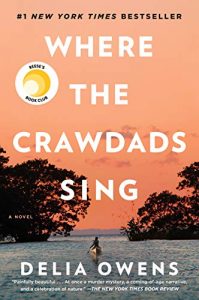I have never before started a post with a direct order, but I’m doing so now:
BUY THIS BOOK.
My reaction to Where the Crawdads Sing was so intensely personal, it made me wonder (again): Why do some books consume me, so that when I look up from reading I have to consciously refocus to regain any sense of where I really am? What kept me reading right through an entire weekend, neglecting other more pressing duties? I don’t have all the answers, but here are some of the elements that make this such an incredibly satisfying read.
Location

“Marsh is not swamp,” the very first sentence states, somehow managing to imply the exact opposite for this ocean-salt-air-lover. Don’t take the cover image too literally; a skiff with an ancient outboard is the main character’s primary source of transportation. Kya Clark, known to townsfolk as The Marsh Girl, could live nowhere else; around her home, “miles of blade-grass so tough” are “interrupted only by trees so bent they wore the shape of the wind.” On every level, this story could’ve only taken place exactly where it’s set.
Structure
After a single opening paragraph set in 1969 that unceremoniously reveals a dead body, we are taken back to 1952 to meet Kya as a little girl—on the “August-hot” morning her Ma walks away for good. A short zoom-out shows the bigger picture—this marsh is guarded by the salty open waters of the Graveyard of the Atlantic—before fading back to a little girl sitting on a front porch stoop, waiting for her mother to return. Her shack’s exact location in the world doesn’t matter to Kya, so author Delia Owens focuses on lyrical descriptions of birds and frogs, marsh grasses and palmettos; the only world our heroine knows.
Then, just as we’re settling in, we are abruptly pulled out of a six-year-old’s head and flashed forward again to 1969 and the identification of that body. It’s a local football hero just past his prime, we learn—and the sheriff smells foul play. The story oscillates back and forth between these two very different realities, with no explanation of how they might be connected. And yet we know—KNOW—they must be.
Trust
That uncertain certainty made me strain to hear what was left unsaid by the characters, and to make connections between what was revealed in each segment. Owens trusts her readers, and so we trust her; even as she focused my attention on scenes so effortless and yet at the same time so stunning, it was as if she was also sitting on my shoulder, promising: “just keep reading; all will be revealed.” A straight-line from start to finish would not have captured my attention nearly so well.
Character
I like to think Kya is based on a real person; that will be one of the many research projects this book sparks, once I’m finished trying to convince you to BUY THIS BOOK. I wish I’d met her, though the odds of that would’ve been slim to none; she rarely left the marsh and kept away from people. Her wisdom is born from reading—coupled with plenty of curiosity, observation, and poetry. And, like her few friends and many enemies, there’s much more going on inside her than we realize.
Deep Twists
Many of the books I read are predictable yet pleasant. This one was mostly neither—and yet my only teensy nitpick is not with the writing, but with the cover image (Kya belongs in a crusty skiff, throttle in hand, not paddling a shiny canoe). Yes, there’s an undying love, but there’s also desertion, abuse, and far more townsfolk who think our main character is an ignorant Marsh Girl than friends who believe in her the way we do. The story continued to surprise—right up until the very last scene.
Just Read It
I’d recommend this book to anyone who wants to live and breathe a world now lost to marsh-draining and air conditioning. There’s as much going on below the surface as there is in plain sight: prejudice, development, education, love and loss—but it’s all tucked away beneath a damn good story, woven around descriptions as rich as Kya’s first night on her own was lonely:
At first, every few minutes, she sat up and peered through the screen. Listening for footsteps in the woods. She knew the shapes of all the trees; still some seemed to dart here and there, moving with the moon. For a while she was so stiff she couldn’t swallow, but on cue, the familiar songs of tree frogs and katydids filled the night. More comforting than three blind mice with a carving knife. The darkness held an odor of sweetness, the earthy breath of frogs and salamanders who’d made it through one more stinky-hot day. The marsh snuggled in closer with a low fog, and she slept.
More Media
I listened to the audiobook version, but I plan to buy a text copy as well—partly to compare the two forms of “reading,” and partly for the joy of re-immersing myself in the Crawdads world. (Note to self: Do not start reading unless there are no chores looming with a tight deadline.)
The movie rights have already been secured, and I’m sure the film will be quite memorable too—though I do wonder where the producers will ever find enough marshy wilderness for filming. But before someone else imparts the “look” of this world onto the big screen, I strongly suggest you view it on the screen between your ears. So I end as this began, with a single instruction: BUY THIS BOOK.
Have you already read Where the Crawdads Sing? Still have it to look forward to? (Insert jealous emoji here.) Either way, share your thoughts in the comments below, or by dropping me an email. Thanks for reading!